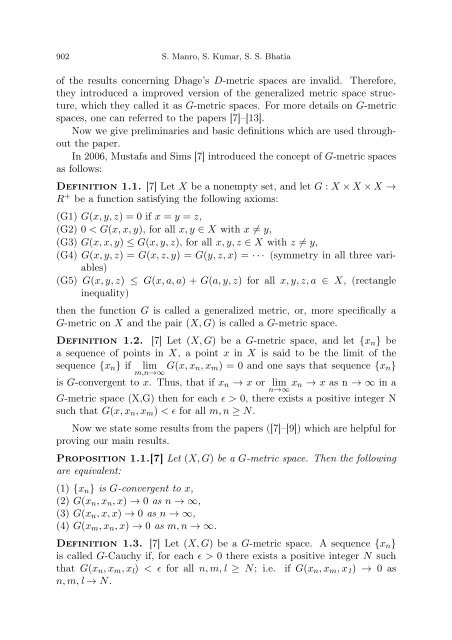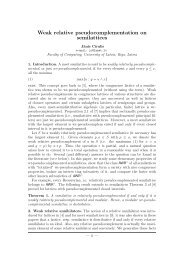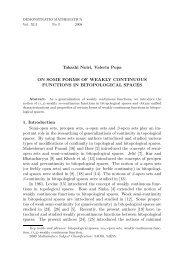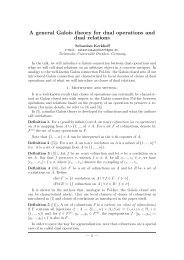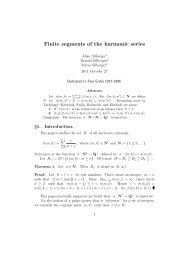(A) IN G-METRIC SPACES 1. Introduction In 1922, Banach
(A) IN G-METRIC SPACES 1. Introduction In 1922, Banach
(A) IN G-METRIC SPACES 1. Introduction In 1922, Banach
Create successful ePaper yourself
Turn your PDF publications into a flip-book with our unique Google optimized e-Paper software.
902 S. Manro, S. Kumar, S. S. Bhatia<br />
of the results concerning Dhage’s D-metric spaces are invalid. Therefore,<br />
they introduced a improved version of the generalized metric space structure,<br />
which they called it as G-metric spaces. For more details on G-metric<br />
spaces, one can referred to the papers [7]–[13].<br />
Now we give preliminaries and basic definitions which are used throughout<br />
the paper.<br />
<strong>In</strong> 2006, Mustafa and Sims [7] introduced the concept of G-metric spaces<br />
as follows:<br />
Definition <strong>1.</strong><strong>1.</strong> [7] Let X be a nonempty set, and let G : X ×X ×X →<br />
R + be a function satisfying the following axioms:<br />
(G1) G(x,y,z) = 0 if x = y = z,<br />
(G2) 0 < G(x,x,y), for all x,y ∈ X with x �= y,<br />
(G3) G(x,x,y) ≤ G(x,y,z), for all x,y,z ∈ X with z �= y,<br />
(G4) G(x,y,z) = G(x,z,y) = G(y,z,x) = ··· (symmetry in all three variables)<br />
(G5) G(x,y,z) ≤ G(x,a,a) + G(a,y,z) for all x,y,z,a ∈ X, (rectangle<br />
inequality)<br />
then the function G is called a generalized metric, or, more specifically a<br />
G-metric on X and the pair (X,G) is called a G-metric space.<br />
Definition <strong>1.</strong>2. [7] Let (X,G) be a G-metric space, and let {xn} be<br />
a sequence of points in X, a point x in X is said to be the limit of the<br />
sequence {xn} if lim<br />
m,n→∞ G(x,xn,xm) = 0 and one says that sequence {xn}<br />
is G-convergent to x. Thus, that if xn → x or lim<br />
n→∞ xn → x as n → ∞ in a<br />
G-metric space (X,G) then for each ǫ > 0, there exists a positive integer N<br />
such that G(x,xn,xm) < ǫ for all m,n ≥ N.<br />
Now we state some results from the papers ([7]–[9]) which are helpful for<br />
proving our main results.<br />
Proposition <strong>1.</strong><strong>1.</strong>[7] Let (X,G) be a G-metric space. Then the following<br />
are equivalent:<br />
(1) {xn} is G-convergent to x,<br />
(2) G(xn,xn,x) → 0 as n → ∞,<br />
(3) G(xn,x,x) → 0 as n → ∞,<br />
(4) G(xm,xn,x) → 0 as m,n → ∞.<br />
Definition <strong>1.</strong>3. [7] Let (X,G) be a G-metric space. A sequence {xn}<br />
is called G-Cauchy if, for each ǫ > 0 there exists a positive integer N such<br />
that G(xn,xm,xl) < ǫ for all n,m,l ≥ N; i.e. if G(xn,xm,x1) → 0 as<br />
n,m,l → N.


